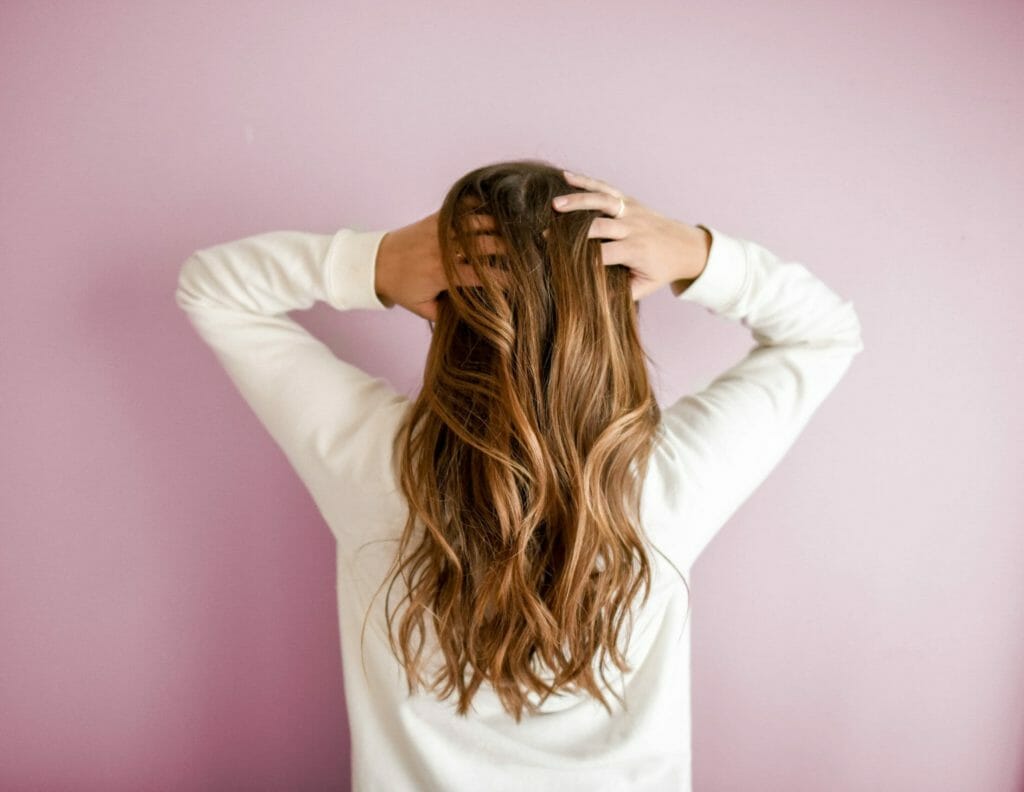How to Make Your Hair Grow Faster

Photo Credit: Element5 Digital
Ask anybody who has consumed several biotin tablets and vitamin E supplements only to be met with identical unimpressive strands to learn how difficult it is to get Rapunzel-like strands. How long does it take for hair to grow, you may ask. The typical rate of hair growth is around half an inch monthly or about six inches annually.
Of course, various factors can impact hair development, including age because we tend to shed hair as we age, general health such as vitamin shortages, and elements like stress and everyday behaviors. Maybe you are wondering how you can make your hair grow faster.
Numerous other strategies promote hair growth, such as physical stimulation via vigorous scalp rubbing. It turns out that massaging your scalp with a few essential natural elements will help your hair keep its length, which will make it seem more like Blake Lively’s. There’s also the egg-yolk mask, and don’t forget the hot castor oil treatment that is so revered.
Your dream hair doesn’t have to seem so out of reach with the variety of available natural and over-the-counter treatment alternatives. Remember that no substance or technique may hasten healthy hair growth from the root. Read below to determine how to develop strong and healthy hair, decreasing breaking at the ends and thus encouraging length.
How Long Does It Take To Grow Your Hair?

Photo Credit: Clarissa Schreiner
You have all the hair follicles you’ll ever have when you’re born. There are roughly 100,000 hair follicles on your head alone. Baldness or hair thinning is brought on by certain strands ceasing to produce hair as you age.
Each hair on your scalp might have a two to six-year growth cycle. There is little information about the prospect of accelerating hair growth, and many are researching how your body’s cells control hair development. Here are the factors that influence your hair’s rate of growth:
- age
- type of hair
- general health
- specific health issues
Stages of Hair Follicles Growth

Photo Credit: Tamara Bellis
About.3 to.4 millimeters per day, or 6 inches, of hair is added to the scalp yearly. Unlike other animals, human hair growth and shedding do not follow a seasonal or cyclical pattern. A random sample of hairs will be in one of the three growth and shedding stages—anagen, catagen, or telogen—at any given time.
Anagen
The active phase of the hair cycle is anagen. During this phase, the hair’s root cells divide quickly. The freshly formed hair pushes the club hair. This hair has stopped growing or is no longer in the anagen cycle, up the follicle, and finally out.
About 1 centimeter of hair develops during this period every 28 days. For two to six years, scalp hair stays in this vigorous stage of development. Some people struggle to grow their hair over a specific length because their active development phase is brief. On the other hand, people with exceptionally long hair have an active phase of growth.
Because it has a concise active growth cycle that lasts just 30 to 45 days, the hair on the legs, arms, eyelashes, and eyebrows is significantly shorter than the hair on the scalp.
Catagen
During this time, hair stops growing for two to three weeks. About 3% of all hairs are always in the catagen phase, a transitional state. This step takes two to three weeks to complete. When growth ends, the outer root sheath contracts and affixes to the hair root. This PHASE is the development of club hair, as the name suggests.
Telogen
It takes 3–4 months for the hair to emerge during the resting phase. Between 6% and 8% of all hairs are typically in the telogen phase, the resting stage. This phase lasts for around 100 days for hair on the scalp, while it lasts longer for hair on the eyebrow, eyelid, arm, and leg.
The hair follicle is entirely at rest, and the club hair fully develops during this stage. A firm, hard, dry, white substance will be visible at the follicle’s root when pulled out during this stage. The average daily telogen hair loss ranges from 25 to 100 hairs.
The typical scalp has 90% of its hair follicles in the anagen phase at any given moment, 1% in the catagen phase, and 9% in the telogen phase. The last group is responsible for the 100 to 150 hair strands that fall daily.
Can the Anagen Phase be Prolonged for Hair Growth?
The length of your hair and if the cells in your follicle base are still increasing and developing into hair cells will determine how long the anagen phase lasts. When matrix cells reach the upper follicle, they lose structural integrity, causing hair to grow. The shed structure joins with keratins to create hair strands that emerge from the surface of your skin.
There is still much to learn about what causes our bodies to enter the anagen phase, and more research is required before it can be determined how to encourage hair growth. Even so, there are things you can do to help grow your hair in a healthy state throughout the anagen period.
What Promotes Hair Health, Growth, and Strength?

Photo Credit: Tamara Bellis
Genetics indeed contribute to sustaining good hair development. However, several additional elements are equally relevant. There are actions you can do to encourage your hair to grow and to prevent breaking, even while there isn’t a magic elixir or prescription that can make your hair grow faster and stronger.
Let’s consider these suggestions that might grow your hair quickly and robustly.
Avoid following a rigid diet.
Not all factors influencing our hair growth are under our control. However, there are many things we may avoid that can lead to slowed development and more shedding. Dietary restrictions can reduce the resources and nutrients required for hair development.
Additionally, hair development swiftly stops when your body is under stress from restricted eating since it has a low priority compared to other biological activities. Hair loss typically lasts for months, even after resuming a healthy diet.
A study of the data indicates that a lack of essential nutrients may affect your hair’s development and structure. Sudden weight loss might result in diffuse alopecia from a niacin shortage or transient shedding known as telogen effluvium (TE).
Examine the amount of protein you consume.
Hair won’t grow as well if your diet is minimal, and shedding may happen. A well-balanced diet with enough protein intake is crucial for optimum hair development. You typically require 50 grams or more of protein per day. The same study mentioned above also suggests that a reduction in protein consumption might result in TE.
Consume goods with caffeine.
Caffeine is well known for improving energy; studies have shown that it can promote hair growth when applied topically. According to research, caffeine in topical products like shampoos and conditioners can stop hair loss and medications. By accelerating cell development and metabolism, caffeine may help in hair growth.
Try using essential oils.
In addition to having a good scent, essential oils such as castor oil could aid in promoting hair growth. In research, women with female baldness saw considerably more hair growth three months after using pumpkin seed oil topically. More extensive research is needed to support this finding further, though.
Additionally, a 2015 study found that rosemary oil may promote hair growth in the same way as minoxidil, the main component of Rogaine. Again, further investigation is required to support this conclusion. A study of the literature published in 2020 found that several essential oils, including peppermint, jojoba, and lavender oil, also potentially halt hair loss.
Increase your nutritional profile.
In addition to being crucial for your general health, specific vitamins, minerals, and fatty acids are vital to giving your body the energy required for hair development. These nutrients may consist of:
- Biotin
- Vitamin C
- Vitamin D
- Vitamin E
- Zinc
- Iron
- Omega-3 and Omega-6
In several studies, vitamin D, folate, and zinc levels were lower in those with alopecia areata, an autoimmune disorder that causes hair loss. According to a 2015 study, women with female pattern baldness may be able to prevent hair loss by taking omega-3 and omega-6 supplements for six months. To conclude, poor nutrition may lead to thinning of hair.
Enjoy a healthy scalp massage.
A head massage can encourage sleep and reduce tension. However, a 2016 study found that it could also improve hair health. A study discovered 18 documented cases that demonstrated a clinical improvement in hair and nail health following biotin intake, despite limited data supporting its effectiveness. Further study is still required To support this.
The 2016 research looked at how well daily, 4-minute scalp massages worked. According to the researchers, the nine males who participated in the study had increased hair thickness after 24 weeks than they had at the beginning. These findings still require the backing of more significant investigations.
Although the research found no discernible change in hair development, massaging the scalp may help widen blood vessels beneath the surface. This phase could result in thicker, stronger hair that is less prone to fall out or damage. You may have a professional scalp massage or indulge in a do-it-yourself treatment at home.
Pause the heat.
Your hair can be damaged and break off when exposed to heat from straighteners, hair dryers, and curling irons. While eliminating heat styling may not be possible, you might consider reducing how frequently you use these products. Using hot styling equipment at lower temperatures might also lessen hair damage.
Additionally, a heat-protectant product before a hot styling tool may considerably lessen hair breakage, according to 2019 research. When utilizing heated equipment, heat treatments function by creating a barrier that helps stop moisture loss.
Be cautious when dyeing your hair.
Chemical operations such as hair dyeing and texture changes can stress the hair, leading to breakage. However, hair might grow quicker when we slow down these processes because fewer hairs fall out.
A 2021 study found that permanent colors can strip the hair of its natural fatty acids. These dyes may be more damaging than alternatives that are not permanent.
Read more: Veila Hair Extensions – The Ultimate Review
Fill your scalp with antioxidants.
Applying antioxidants topically to the scalp has been shown in clinical tests to drastically prevent hair loss and enhance scalp health.
In 8-week research, women used shampoo or leave-in scalp treatment containing the antioxidant piroctone olamine. They had considerably more hair and healthier scalps than those who used placebo formulations.
The outcomes of another 24-week research were comparable. Piroctone olamine and other antioxidants in a leave-in scalp therapy significantly reduced hair loss compared to individuals who received a placebo. The scalp barrier may be strengthened and protected by these components, which, according to researchers, will prevent further hair loss.
Frequent hair cutting.
Regular hair cuts can encourage the growth of healthy hair. Removing split ends stops them from growing higher up your strands and damaging your hair. Contrary to common perception, frequent haircuts won’t cause your hair to grow more quickly. No matter how often you trim it, your hair grows at around half an inch every month.
Don’t let your hair break.
When the scales that keep the strands together in your inner hair cuticles break off, hair breakage, dryness, and frizz can result. Try doing the things below to avoid this from happening:
- Eating foods high in nutrients that build hair, such as folic acid, iron, and zinc
- Focusing on your scalp while using shampoo
- Conditioner use
- Blotting rather than stroking your hair while you dry it with a towel
- If possible, let your hair naturally dry rather than using a blow dryer.
- Keeping from overbrushing
- Utilizing only natural bristle brushes to style your hair
Reduce your tension.
According to research, persistent stress might cause hair loss. Your follicles might enter a resting period as a result, when they would shed hair rather than generate new ones. Some all-natural methods to relieve stress include:
- Exercise
- Meditate
- Keep a journal
- Eat a balanced diet
When should you have a hair growth checkup?
Any concerns about your hair, such as severely damaged or limited hair development, should be discussed with a doctor. They can do a possible nutritional deficiency assessment and suggest certain items that can be beneficial.
You should visit your doctor if you’re suffering from unexplained and significant hair loss because several medical issues might result in hair loss. In some situations, addressing the underlying reason may be able to stop hair loss problems.
Conclusion

Photo Credit: Averie Woodard
Poor diet is one of the primary reasons people lose their hair. So, if you want to keep your locks in good condition, eating a balanced and healthy diet is essential. Ensure you drink enough water, too – dehydration can lead to hair loss.
If you are experiencing unexpected or substantial hair loss, it might be worth seeing a doctor. They will be able to look for any underlying factors causing the problem. Taking care of your health can help ensure that you have fuller-looking hair!

